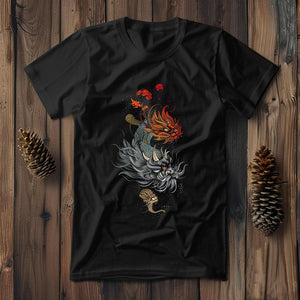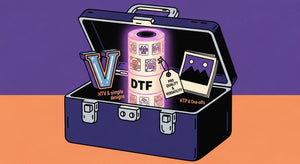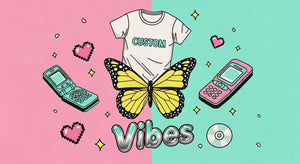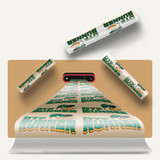Table of Contents
- What Are DTF Prints?
- DTF Prints vs. Heat Transfer Vinyl (HTV)
- DTF Prints vs. Sublimation
- DTF Prints vs. Screen Printing
- Benefits of DTF Prints
- Common Uses for DTF Prints
- Tips for Choosing the Right Transfer Method
- Tips for Enhancing DTF Print Quality
- Troubleshooting Common Issues with DTF Prints
- The Future of DTF Prints
- Frequently Asked Questions about DTF Prints
- Conclusion: Transfer Methods for DTF Prints
With custom apparel, several transfer techniques take center stage, all touting their benefits and presenting challenges. This content pits DTF prints against other popular techniques of transfers to help you make your pick.
What Are DTF Prints?
Basically, DTF prints have grown to become a game-changer in custom apparel. Unlike traditional methods, DTF prints allow for complex and vibrant designs, making them a preferred choice for many. This article will compare DTF prints with other transfer methods like Heat Transfer Vinyl (HTV), Sublimation, and Screen Printing to give you a comprehensive understanding of their differences.
DTF prints involve printing designs onto a special film and then transferring them onto fabric using heat. This method stands out for its ability to produce detailed, high-quality prints that are both durable and vibrant. DTF prints are compatible with a wide range of fabrics, including cotton, polyester, and blends.

DTF Prints vs. Heat Transfer Vinyl (HTV)
Quality and Detail:
- DTF Prints: Known for producing highly detailed and vibrant images, DTF prints can handle complex designs with ease.
- HTV: While HTV can do solid colors and simple designs fairly easily, it is grossly challenged by complex patterns or color gradients.
Durability:
- DTF Prints: Offer excellent durability, maintaining their quality through many washes.
- HTV: Also durable, but may peel or crack over time, especially if not applied correctly.
Application Process:
- DTF Prints: Requires a heat press and a special DTF printer. The process is straightforward but needs precise settings.
- HTV: Involves cutting designs from vinyl sheets and applying them with a heat press. The process can be time-consuming for detailed designs.
Versatility:
- DTF Prints: Suitable for various fabrics and offers flexibility in design choices.
- HTV: Limited to solid colors and less complex designs but works well for basic, bold graphics.
DTF Prints vs. Sublimation
Color Vibrancy and Quality:
- DTF Prints: Provides vibrant and detailed prints suitable for various colors and fabrics.
- Sublimation: Known for vibrant colors, but works best on polyester fabrics. Sublimation on cotton requires special coatings.
Fabric Compatibility:
- DTF Prints: Compatible with a wide range of fabrics, including cotton, polyester, and blends.
- Sublimation: Primarily effective on polyester or polyester-coated substrates.
Durability:
- DTF Prints: Highly durable and resistant to fading and cracking.
- Sublimation: Extremely durable, with colors becoming part of the fabric, but limited by fabric type.
Application Process:
- DTF Prints: Involves printing on film and transferring with heat.
- Sublimation: Needs special sublimation ink and paper. The process consists of pressing heat onto the sublimation paper onto a substrate.
DTF Prints vs. Screen Printing
Detail and Complexity:
- DTF Prints: Can produce highly detailed and complex designs with ease.
- Screen Printing: Best for simple designs with few colors. Complex designs require multiple screens, increasing cost and effort.
Cost:
- DTF Prints: More cost-effective for short runs and custom orders due to its flexibility.
- Screen Printing: Economical for large batches, but setup costs for multiple screens can be high for short runs.
Durability:
- DTF Prints: Durable and maintains quality through numerous washes.
- Screen Printing: Highly durable but can fade or crack over time if not properly cured.
Application Process:
- DTF Prints: Straightforward process using a heat press and DTF printer.
- Screen Printing: It means that one has to make a screen for each color, then pass ink through the screens onto the fabric. The process is very labour-intensive and requires huge setup.
Benefits of DTF Prints
Given the comparisons, DTF prints offer several advantages:
- Vibrant Colors: DTF prints provide bright and vibrant colors that stand out.
- Durability: They are highly durable and can withstand multiple washes without fading.
- Versatility: Suitable for a wide range of fabrics and design complexities.
Common Uses for DTF Prints
DTF prints are ideal for various applications, including:
- Custom Apparel: T-shirts, hoodies, and sportswear with intricate designs.
- Merchandise: Tote bags, hats, and accessories.
- Corporate Branding: Uniforms and promotional items.
- Personalized Gifts: Custom-designed items for special occasions.

Tips for Choosing the Right Transfer Method
When deciding between DTF prints and other transfer methods, consider the following factors:
- Design Complexity: Choose DTF prints for intricate and colorful designs.
- Fabric Type: Ensure the chosen method is compatible with the fabric you’re using.
- Durability Needs: Consider how often the item will be washed and used.
- Production Volume: Balance cost and efficiency based on the number of items you need.
Tips for Enhancing DTF Print Quality
For those looking to take their DTF printing to the next level, consider these advanced tips:
- Using Pre-Treatment: Pre-treated sprays are sometimes beneficial to certain fabrics and allow the print to adhere better because they contain a spray solution. This is really effective with cotton fabric and high-content polyester garments.
- Color Management: Use color management software to ensure your designs are printed with the correct color profiles. This ensures the colors in your design match the final print.
- Multiple Presses: For bigger designs, consider sectionally pressing your print for perfect pressure and heat distribution. This is what could prevent under-pressure on any part of the design.
- Use Quality Materials: Invest in high-quality DTF film and inks.
- Proper Heat Press Settings: Ensure your heat press is correctly calibrated for temperature, pressure, and time.
- Post-Pressing Care: Let the garment cool down completely before handling, and follow recommended washing instructions.
Troubleshooting Common Issues with DTF Prints
Despite following the instructions, you may encounter some common issues. Here’s how to troubleshoot them:
- Peeling Edges: If the edges of the print are peeling, it might be due to insufficient pressure or heat. Ensure your heat press is evenly distributing pressure and that the temperature is set correctly.
- Dull Colors: Dull or faded colors can result from incorrect temperature settings. Make sure the heat press is set to the recommended temperature for DTF prints.
- Incomplete Transfer: If parts of the design are not transferring, check that the entire print is making contact with the fabric. Adjust the pressure and ensure there are no wrinkles in the garment.
The Future of DTF Prints
As technology progresses, DTF printing is only going to become more prevalent and easier. Innovations in materials and equipment will likely further improve the quality and ease of printing, making this technique one of choice for custom apparel.
Frequently Asked Questions about DTF Prints
1. Can I apply DTF prints to any fabric?
DTF prints are versatile and can be applied to a variety of fabrics, including cotton, polyester, and blends. However, it's always a good idea to test a small area first to ensure compatibility.
2. How long do DTF prints last?
If properly cared for, DTF prints easily survive many wash cycles without great fading or peeling. They have a reputation for being tough when compared to other methods of transfer.
3. Do I need special ink for DTF printing?
Yes, DTF printing requires specific DTF inks that are designed to adhere to the transfer film and then to the fabric during the heat press process. Regular inks will not work for DTF printing.
4. What type of heat press should I use?
While any quality heat press can work for DTF transfers, a machine that allows for precise control of temperature, pressure, and time will yield the best results.
5. Can DTF prints be layered?
Yes, one can do layering for DTF prints to come up with complex designs. However, ensure that each layer is applied and cooled properly before putting on the next in order to avoid any adhesion issues.
Conclusion: Transfer Methods for DTF Prints
DTF prints provide a versatile, high-quality solution for custom apparel. What really makes them outstanding is that they can achieve detailed, colorful designs on different kinds of fabrics. While other methods, like HTV, sublimation, and screen printing, all have their strengths, DTF prints provide truly one-of-a-kind detail, durability, and versatility. Knowing the differences between them will let you make an informed decision that best suits your needs.
Whether you're new to DTF printing or looking to refine your technique, this guide provides the comprehensive information you need. We hope that this content is helpful to you. Happy printing!






